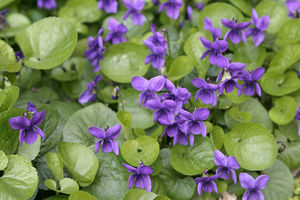The flower most frequently associated with the month of February is the violet (Viola odorata). The violet represents faithfulness, chastity, and humility. The ancient Greeks believed that the god Zeus gave the goddess Io pastures of violets to eat after turning her into a cow to protect her from a jealous Hera. In addition, the violet was the symbol for Athens. Napoleon Bonaparte also used the violet for his emblem, while he and Josephine exchanged bouquets of this little flower as symbols of their love for one another. Fragrant violets have been used in perfumes over the years, as well, and can be found in potpourris and nosegays.
It is believed that the violet has been cultivated for at least 2,000 years. While these small flowers – they only grow to be 4-6 inches tall – might seem to be rather inconspicuous, they are favorites for shade and rock gardens. The small purple flowers rising from clumps of dark green leaves are a welcome sight in the late winter and into the early spring. I remember when I was growing up and responsible for taking care of the yard that I would put off mowing an upper section of our yard. That section was always covered with violets, which I just loved. The sight of that blanket of violets also led to their becoming one of my favorite flowers.
Violets prefer shade or dappled sun, which makes them excellent for woodland gardens. They also like the rich soil full of organic matter that is found in these woodland areas. You do want to make sure that the soil is moisture-retentive yet drains well. Gardening books may tell you how deep to plant violets, how far to space them, and other such planting requirements. I have found, however, that I have never needed a gardening book or some complicated set of instructions in order to grow violets. They re-seed quite happily plus spread through runners and will naturalize quite easily in your yard without your doing anything but maybe mowing them down after they have bloomed. As a result, I simply dig up any wayward violets and move them to the area I would rather they inhabit. I then water them and get out of the way. They will need to be thinned out from time-to-time, though. When you do this, be sure to cut off the runners in order to force nutrients back to the crowns.
There are now many varieties of violets from which to choose. You can find violets in not only the traditional light to dark purple but also in white, yellow, blue, black, apricot, red, and multicolor. Some varieties can handle full sun, and some will bloom through the summer. Most are hardy in zones 5-9. Following are some other varieties you might want to include in your landscape. Also, remember that it is not necessary to have been born in the month of February to enjoy violets in the garden.
Horned Violet (V. cornuta). Fragrant. Pale purple to purple blooms. Full sun to partial shade. Zones 6-9.
Labrador Violet (V. labradorica). Light bluish-purple blooms. Great ground cover. Zones 3-8.
Hybrids include: ‘Arkwright’s Ruby’ (red flowers), ‘Baby Franjo’ (pale yellow blooms), ‘Molly Sanderson’ (black blooms through the summer), and ‘Rebecca’ (white blooms with dark violet edges).






